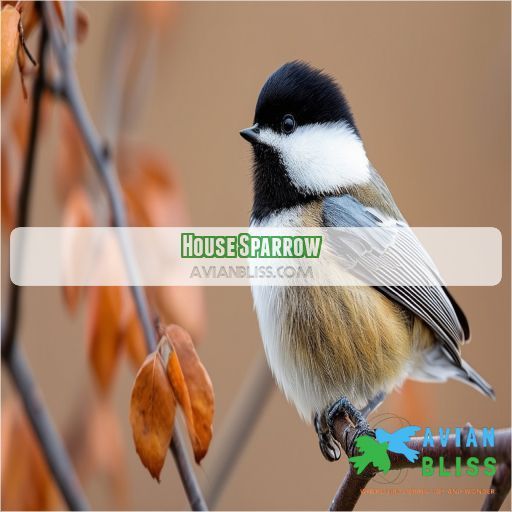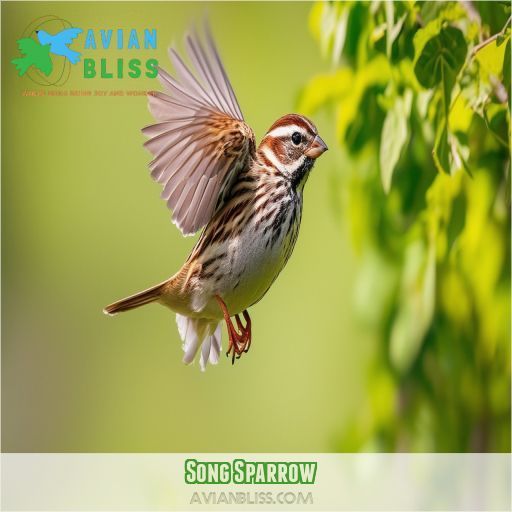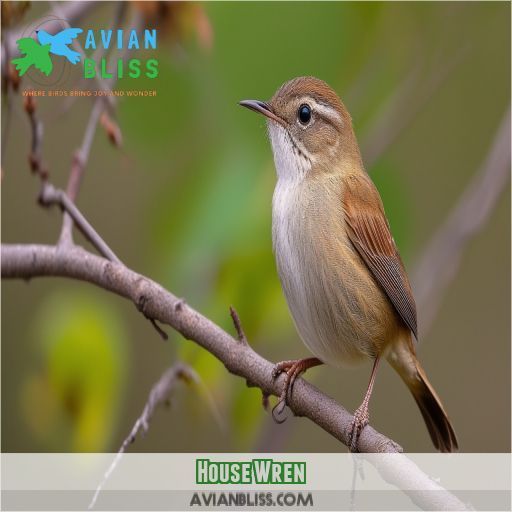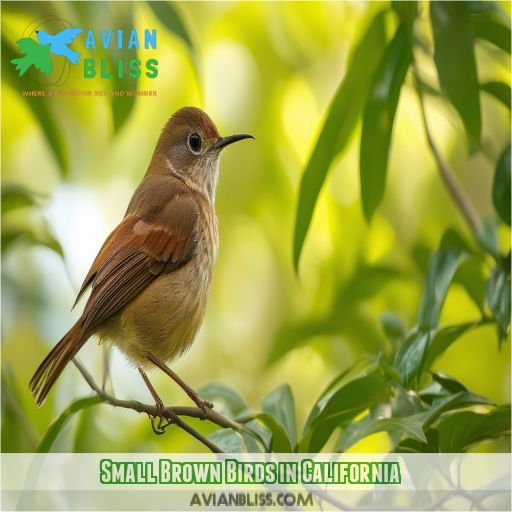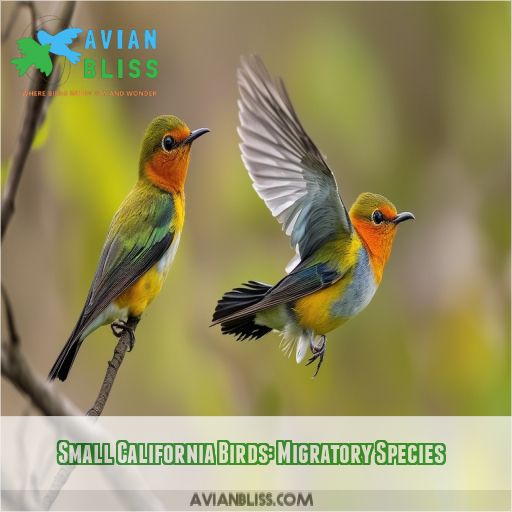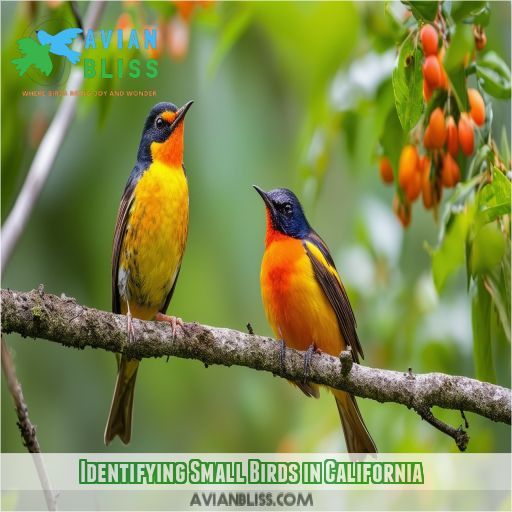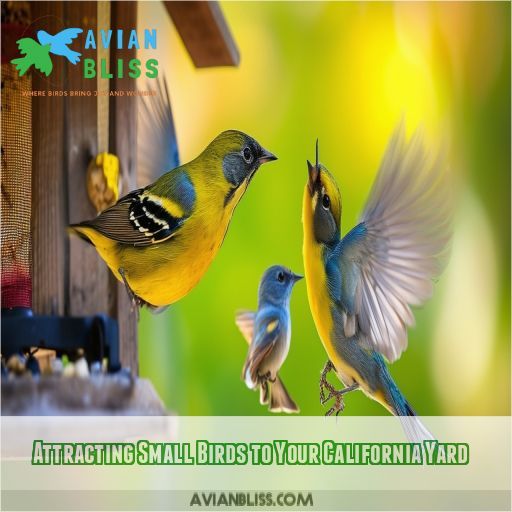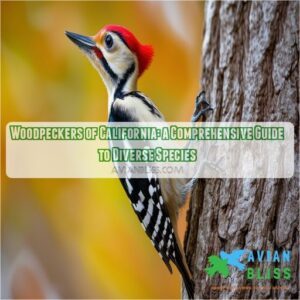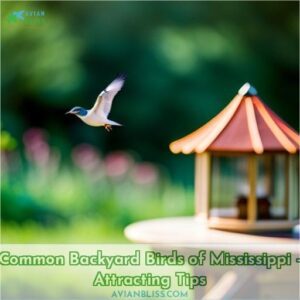This site is supported by our readers. We may earn a commission, at no cost to you, if you purchase through links.
 Birds of a feather flock together—but how can you tell them apart?
Birds of a feather flock together—but how can you tell them apart?
There are many small birds in California, but the ones you’ll spot most often are sparrows, finches, and wrens.
These tiny birds usually weigh less than an ounce, so you might not even notice them at first.
This article will help you identify the top 10 small birds in California and show you how to attract them to your backyard.
Table Of Contents
- Key Takeaways
- House Sparrow
- Song Sparrow
- House Wren
- White-crowned Sparrow
- Small Brown Birds in California
- Additional Small California Birds
- Small California Birds: Migratory Species
- Small California Birds in Different Seasons
- Identifying Small Birds in California
- Attracting Small Birds to Your California Yard
- Frequently Asked Questions (FAQs)
- What is the most common bird in California?
- What are the tiny gray birds in Southern California?
- What is the most common small bird?
- What is a small California bird with a black head?
- What are the key characteristics of small birds in California?
- Are there any small birds commonly found in backyards?
- How do small birds in California differ from other birds?
- What unique behaviours or habits do these birds display?
- When is the best time to observe migratory small birds?
- Conclusion
Key Takeaways
- California’s small birds come in a variety of shapes and sizes, from the tiny House Wren to the slightly larger White-crowned Sparrow.
- These birds have adapted to a range of habitats, whether it’s urban backyards or mountain forests.
- Attracting these small birds to your yard can be as easy as taking a few simple steps, such as providing food, water, and shelter.
- Observing these small birds is an excellent way to connect with nature and learn about California’s unique wildlife.
House Sparrow
You’ll likely spot House Sparrows zipping around your California backyard. These small, adaptable birds have made themselves at home in urban and suburban areas. With their chubby bodies and short tails, they’re easy to identify. Males sport gray crowns, chestnut-colored backs, and black bibs, while females are a more subdued brown.
House Sparrows aren’t picky eaters. They’ll happily feast on seeds, crumbs, and insects. You’ll often see them foraging on the ground or boldly raiding your bird feeders. These social creatures prefer to live in colonies, chattering away with their distinctive "cheep" calls.
While they’re common, House Sparrows face conservation challenges. Their numbers have declined in some areas due to habitat loss and competition. By providing bird-friendly spaces and feeders, you can help these feathered neighbors thrive in your California backyard.
Song Sparrow
While House Sparrows dominate urban areas, you’ll find Song Sparrows in more diverse habitats. These small California birds are a favorite among bird watchers, thanks to their melodious tunes and adaptable nature. You’ll recognize them by their distinctive song structure: three short notes followed by a trill. But don’t be fooled – their calls can vary depending on location and individual bird!
Song Sparrows prefer wet, shrubby open areas, where they build cup-shaped nests in low vegetation. Their diet composition is diverse, including insects, seeds, and berries. Luckily, their conservation status is of least concern, so you’ll have plenty of chances to spot them.
To attract these feathered friends to your yard, create brush piles and plant native shrubs. With a bit of patience, you’ll soon be enjoying their beautiful songs right from your backyard!
House Wren
While song sparrows prefer open areas, you’ll find house wrens zipping through your backyard with boundless energy. These tiny brown birds, measuring just 4.3 to 5.1 inches, are common California residents. You’ll often spot them darting in and out of brush piles, hunting for insects.
Their diet consists mainly of spiders, caterpillars, and beetles, making them excellent natural pest control for your garden.
House wrens are known for their beautiful, energetic, and flute-like melodies. These songs aren’t just for show – they’re critical for attracting mates and defending territory.
To encourage these feathered friends to visit, create brush piles in your yard. While house wrens aren’t currently of conservation concern, providing suitable habitats helps guarantee their continued presence.
Keep an ear out for their cheerful tunes – you might just find yourself with a new backyard buddy!
White-crowned Sparrow
While House Wrens captivate with their energetic melodies, your California backyard might also welcome a more distinguished visitor: the White-crowned Sparrow. You’ll spot these dapper birds by their striking black-and-white striped crowns, which make them stand out from their sparrow cousins. At 6-7 inches long, they’re slightly larger than House Wrens but still fall into the "small bird" category.
White-crowned Sparrows prefer open habitats with shrubs and are often seen hopping on the ground, foraging for seeds and insects. During migration, they might pop into your yard for a quick snack at your feeder.
To attract them, offer millet or cracked corn on platform feeders. Keep your eyes peeled for their distinctive head pattern, and listen for their sweet, whistling song – it’s a sure sign that these charming visitors have arrived.
Small Brown Birds in California
Small brown birds are a common sight in California, and you can spot a variety of species in your backyard with relative ease. The House Wren, for instance, is a tiny bird with a loud voice and a brown hue, often seen zipping through yards in search of insects. The Rock Wren, on the other hand, is a brown, gray, and white-speckled bird that favors the mountains and is a replacement for the House Wren in those habitats.
Another common backyard bird is the female House Finch, easily identified by her brownish-gray plumage. Keep an ear out for the Dark-eyed Junco, a small, slate-colored bird with a white belly and a penchant for hopping along the ground in search of food. Their song is a sweet, high-pitched trill, often ending with a buzzy note.
Additional Small California Birds
While the previous section focused on small brown birds, there are other unique and colourful birds to discover in California.
One such bird is the Verdin, with its yellow face and piercing dark eyes. It can be found in the state’s arid regions. The Cactus Wren, with its grayish-brown plumage and long, downturned bill, builds its nest among cacti, as its name suggests.
Black-chinned Hummingbirds are adaptable and thrive in various habitats. They’ve a distinctive black head and throat. The brilliant yellow Yellow Warbler, with its reddish stripes, is a summer visitor to the state.
Small California Birds: Migratory Species
California is a bird-watcher’s haven, particularly for migratory species. These seasonal birds include the Lesser Goldfinch, Pine Siskin, and Lawrence’s Goldfinch. These birds exhibit intriguing migratory behaviors, habitat preferences, and breeding patterns. For instance, the Lesser Goldfinch is exclusively vegetarian, favoring sunflower and Nyjer seeds. They also tend to breed later than other birds.
The Pine Siskin, conversely, is a partial migrant, opting to reside in areas with ample food resources. These birds are remarkably adaptable and inhabit diverse ecosystems, ranging from forests to urban parks.
Bird migration is a fascinating spectacle, and California is an ideal location to witness it. The state’s varied landscapes and climates provide a sanctuary for migratory birds, offering a unique opportunity to observe their behaviors and admire their beauty.
Small California Birds in Different Seasons
Now that you know about the small migratory birds in California, let’s explore the seasonal variations in the state’s bird populations. California’s diverse landscapes and climates offer a range of habitats for birds, and understanding these seasonal changes can enhance your birdwatching experiences.
The timing of your backyard observations can greatly impact the species you spot. Different birds thrive in California’s varying seasons, so here’s a guide to help you make the most of your birdwatching throughout the year:
- Spring and Summer: These warmer months bring a variety of breeding and migratory birds to California. Keep an eye out for colorful songbirds like the Black-capped Chickadee, Downy Woodpecker, and American Goldfinch. These species are active and vocal, making them perfect subjects for bird photography.
- Fall and Winter: As temperatures cool, you’ll notice a shift in bird activity. Some species migrate south, while others become more active in their search for food. The Red-breasted Nuthatch and Mountain Chickadee become more visible during these months, providing unique birdwatching opportunities.
California’s bird populations are ever-changing, and by understanding these seasonal patterns, you’ll be able to spot a greater variety of species throughout the year. So, grab your binoculars and get ready to explore California’s diverse avian life in all seasons!
Identifying Small Birds in California
Identifying small birds in California can be a fun and challenging endeavor. Here are some tips to help you become a pro at bird identification:
- Physical characteristics: Take note of the bird’s size, plumage color, and distinctive features like tail length or beak shape.
- Habitat preferences: Different birds favor different habitats. Observe whether they prefer fields, meadows, or more urban environments.
- Nesting behavior: Pay attention to where birds build their nests—in trees, shrubs, or on the ground.
- Feeding habits: Learn about the dietary preferences of different bird species. Some, like the American Goldfinch, are strict vegetarians, while others, like the House Sparrow, are less picky.
- Conservation status: Some birds are more common than others. Keep an eye out for invasive species like the House Sparrow, and rare birds like the California Condor, which has an impressive wingspan of up to eight feet.
Attracting Small Birds to Your California Yard
Now that you can identify these small birds, you can attract them to your yard. Here are some tips to create a bird-friendly habitat:
- Bird feeders are a great way to attract small birds. Offer a variety of seed types, such as sunflower seeds or a bird seed mix.
- Water features like birdbaths or streams will also entice these birds to your yard, as they need a reliable water source for drinking and bathing.
- Plant native plants to provide food and shelter. Native plants are adapted to the local climate and can provide a natural food source for birds.
- Let your grass grow long to provide cover and a natural source of seeds for foraging birds.
- Avoid using pesticides and herbicides, which can be harmful to birds and other wildlife.
Frequently Asked Questions (FAQs)
What is the most common bird in California?
The most common birds in California include the Western Gull, European Starling, Red-winged Blackbird, Anna’s Hummingbird, California Scrub-Jay, and House Finch.
What are the tiny gray birds in Southern California?
You’re likely to find mockingbirds, bushtits, Clark’s nutcrackers, and gnatchers. Mockingbirds are plump, with large heads and long tails. Bushtits are very small and active. Clark’s nutcrackers have bright white tail feathers and live in coniferous forests in the mountains. Gnatcatchers are tiny, with slender tails.
What is the most common small bird?
The House Wren is a common small bird in California. You’ll often see them zipping through backyards hunting insects. They’re brown with a short tail, thin bill, and dark barring on their wings and tail.
What is a small California bird with a black head?
The male California Gnatcatcher is a small bird with a black cap and a black tail narrowly edged in white. The White-crowned Sparrow also has black-and-white stripes on its head.
What are the key characteristics of small birds in California?
You’ll find a variety of small birds in California, from the yellow-faced Verdin with its slim beak to the bright green Anna’s Hummingbird, the smallest bird in the state. There’s also the blue-gray Gnatcatcher, a partial migrant, and the Yellow-rumped Warbler, a tiny songbird with yellow patches.
Are there any small birds commonly found in backyards?
Yes, you can find the House Wren, Bewick’s Wren, White-Crowned Sparrow, and Bushtits in your backyard. They may be hard to spot due to their small size and plain colouring, but they’re common.
How do small birds in California differ from other birds?
Small birds in California differ from other birds in a few ways.
The Black-chinned Hummingbird, for instance, is less aggressive than its fellow hummingbirds.
The Western Bluebird is a permanent resident, unlike its northern counterparts, which migrate.
The House Wren surprises with its loud voice.
The Yellow-rumped Warbler is marked by a yellow rump and flank.
The Chipping Sparrow, meanwhile, sports a chestnut crown.
What unique behaviours or habits do these birds display?
Burrowing owls, for example, have unique nesting habits, digging their own underground burrows. They’re also diurnal, active during the day. Treecreepers, on the other hand, use their thin, down-curved bills to extract insects from bark.
When is the best time to observe migratory small birds?
Migratory birds typically arrive in California in the fall, with peak migration occurring in October and November. So, if you’re keen to observe these small birds in action, mark your calendars for autumn and get ready for a spectacular show.
Conclusion
Like pieces of a colorful puzzle, California’s small birds add a vibrant touch to the state’s natural tapestry.
This article has provided an in-depth guide to help identify the top 10 small birds in California, highlighting their unique characteristics and behaviors.
By understanding these fascinating creatures, you can now easily spot them in your own backyard and appreciate the beauty they bring to the state.
From the familiar House Sparrow to the melodic Song Sparrow, these tiny birds are sure to delight and surprise with their presence.

